5.1 EARLY MAN’S FOOD
Early man was primarily a hunter and a flesh-eater. He also ate fruits and seeds. He did not cultivate food. He was a food gatherer. He and his family had to go without food when the weather was rough This made him change his habit to domesticating cattle and growing of plants along his dwelling units. This enabled him to make use of food available around his home in case he could not go for hunting Since man, animals and plants require water all-round the year, people started settling near rivers, lakes and ponds. This was the beginning of food production by man.

5.2 AGRICULTURE AND FARMING
When man adopted to plant eating along with flesh eating, he started collecting seeds. The seeds were scattered, germinated and grew. The produce of the plants was used as food and the plant body was left as fodder for cattle. With the increase in demand for food, man became aware of taking care of plants. This was the beginning of agriculture. The word agriculture has come from two latin words, ager meaning field and culture meaning cultivation. Agriculture or farming is the cultivation of soil. It includes growing of plant crops and rearing of animals.

5.3 FOOD FROM PLANTS
Food from plants includes : Cereals, Pulses, Fruits, Vegetables. We also use oils and beverages as part of our food. The plants cultivated on a large scale specially for food are called food Crops.
Cereals : The important cereals include Corn, Wheat and Paddy.
Cereals provide us, Starch, Fibres, Minerals, Some vitamins, Proteins.

Pulses : The important pulses include Pea, Beans and Peanuts. Pulses are rich in : Starch, Fibres, Minerals, Some vitamins, Proteins.
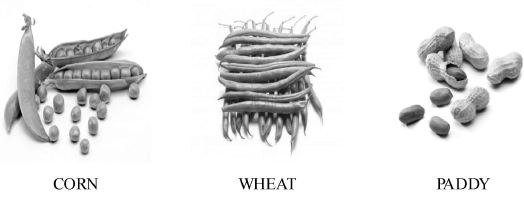
Fruits and Vegetables
They provide us : Nutrients, Minerals, Vitamins, Proteins, Carbohydrates, Gel.
Crops
All the plants that gives us food are grown in groups called Crops. Depending on the time and place of their growth, crops are classified into two types.
Herbaceous Crops
These are crops grown in a particular season.
i) Kharif Crops
The seeds of these crops sown June/July. The crops are harvested in September/October.
Examples : Sorghum, Sugarcane, Pearl millet, Pulses, oil seeds, etc.
ii) Rabi Crops
These are also known as Winter Crops. The seeds of these crops sown October/November. The crops are harvested in March/April. Winter flowers and winter vegetables are grown.
Examples : Wheat, Barley, Pea, Oats, etc.
iii) Zayed Crops
These are also known as Summer Crops. The seeds of these crops sown March/April. Summer flowers and Summer vegetables are grown. The crops are harvested in May /June.
Examples : Cucurbita, Lagenaria, Bitter Gourd, Melons, etc.
Shrubs and Trees
These crops are also known as Plantations. They are cultivated in forests, on orchards or farms.
Examples : Tea, coffee, cocoa, mango, apple, guava, plums, roses, etc.
5.4 FOOD PRODUCTION AND FARM MANAGEMENT
India is primarily an agricultural country. Water is one of the important requirements for growing crops. For water, farmers mainly depend on rain.
Need for better Agricultural Practices
Monsoons may fail at times. With the help of scientific and technology, arrangements must be made which should help the farmer with water all-round the year. Also, more and better yields from fields much be achieved.This is possible by adopting better agricultural practices and farm management. Farming. The tasks performed by a Farmer for tilling a farm and for cultivation is called Farming.
Farming Practices
The different farming practices are :
(i) Soil Preparation
(ii) Seed Selection
(iii) Seed Sowing & Planting
(iv) Soil Fertility
(v) Weeding
(vi) Irrigation
(vii) Harvesting
(viii) Crop protection
(ix) Storage
5.5 SOIL PREPARATION
i) Tilling : The preparation of soil before planting a crop is called tilling of the soil. Compost (manure prepared from decayed animal and plant wastes) is placed in small heaps which is then ploughed.
ii) Ploughing : Ploughing helps in loosening and turning the top soil upside down and also in mixing the compost with the top soil. This makes the soil fertile, airy and increases its water retaining capacity. It also helps in uprooting weeds and exposing seeds, worms, insects and pests in the fields.
iii) Levelling : Large lumps of soil are broken with a harrow. The soil is then levelled or made into ridges and furrows. Levelling ensures uniform distribution of water in the field.

Tools in Soil Formation
Some of the farming tools are :

A plough is a sharp pointed wedge that cuts into the soil. It also turns the soil bringing the lower mineral rich soil to the top. Today, farmers use tractors to draw and drag a multipronged plough.
5.6 SEED SELECTION AND SOWING
Seed Selection
Good quality seeds are important for better yield. Some of the good qualities of seeds are :
i) Clean, not mixed with the seeds of weeds.
ii) Dry, solid and healthy
iii) Free from fungal spores, pests or insects
iv) Of good breed (hybrid seeds or Gm seeds)
Seed Sowing
Sowing is the process of putting seeds in the soil
Method of sowing depends on the type of crop.
i) Before sowing the good and healthy seeds are selected and treated with pesticides like ‘agrosan’
ii) Treatment of seeds with pesticide protects the seeds from being eaten away by birds and from fungal or bacterial growth upon them while sprouting.
Methods of Seed Sowing
i) Broadcasting
Sowing of Seeds by spreading or sprinkling in the field is called Broadcasting of seeds. Seeds of crops like barseem and coriander are spread or sprinkled in the field.

ii) Dribbling
The seed is placed in a small hole in the soil and then the hole is covered with soil.
iii) Drill Sowing
Seeds are sown with the help of ‘seed drill’. Seeds of wheat, maize, barley and millets are sown in rows and in furrows at a particular depth along the field. Seed drill is a funnel with a long and hollow stem. The farmer puts the seeds into the funnel and the seeds go down the stem, one by one, to get into the soil.
Mechanized drills attached to tractors are used on big farms.

Seed Sowing – Problems
i) Seeds left on the surface of the soil may be carried away by wind are destroyed by the insects and birds.
ii) Seeds sown close to one another may result in overcrowding thereby resulting in hampered growth.
iii) Seeds placed deep inside the soil may fail to germinate and fail to come out into the air.
Seed Sowing – Precautions to be taken
i) Except for the seeds which are sown by broadcasting, the seeds are sown at :
ii) An appropriate distance from one another
iii) A particular depth under the soil
Preparing Nursery Plants
In the case of paddy specially and most of the seasonal vegetables and flowering plants, initially the seeds are sown in a nursery to obtain saplings. Saplings are then transplanted into the fields placing them at a proper distance from one another. Transplanting helps in planting only healthy plants and at a proper distance from one another. Rearing seedlings to saplings in a nursery helps in eliminating weak saplings.
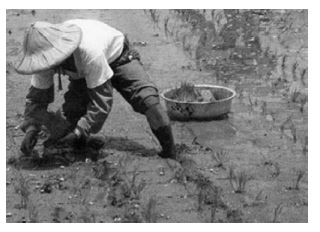
5.7 IMPROVISING SOIL FERTILITY
Top soil supports plant life. Herbs (crops) grow in top soil and derive their mineral nutrition from it. Once a crop is harvested, the top soil in which the top soil has been growing gets poor in minerals. This soil needs enrichment with minerals before another crop is planted on it. First thing a farmer does is to plough the fields. Ploughing turns the soil and brings the leached minerals up from the soil below. Ploughing may not help much in improving the soil fertility. The lost plant nutrients in the soil are replenished with the addition of fertilizers.
Fertilizers
Fertilizers are the substances which contain nutrients essential for plant growth. The types of fertilizers are :
(i) Natural fertilizers or organic fertilizers
(ii) Chemical fertilizers or inorganic fertilizers
Natural Fertilizers
Natural fertilizers include naturally occurring organic materials or naturally occurring mineral deposits. Manure or compost is the decomposed plant and animal waste (farm waste including animal droppings), waste food, dead and dry leave and offal (includes garbage and dried left over flesh from slaughtering animals) goes into the making of the compost
Manure – Its Preparation
• Compost is prepared by the farmers on their farms
• A deep pit is made in a corner of the field which is filled with farm waste, straw and dead leave from time to time
• This is covered with a layer of soil and is moistened by sprinkling water over it from time to time
• Worms, insects and microbes grow on it and help in decay the organic matter, turning it into humus
• Humus is rich in minerals, microbes and decayed organic matter
Green Manure
Green manure is a type of cover crop grown primarily to add nutrients and organic matter to the soil. There is a time gap between harvesting a crop and sowing of the next crop. Instead of leaving the field without any plants on it during the gap period, a fast growing leafy leguminous fodder crop such as Trifolium (Barseem), or Alfalfa or Sesbania is sown This crop come up soon and it yields green leafy fodder for the cattle. The roots of these plants bear root nodules with nitrogen fixing bacteria. This enriches soil with mineral nutrients.
While preparing the field for sowing the next crop, the field is ploughed along with green leguminous crop and it’s nodule bearing roots. The green plants along with the roots go into the soil and decompose to form organic manure (compost).
Nitrogen Fixation
It is the natural way of fixing nitrogen in the soil. Body of living organisms is made of proteins. Proteins are compounds of nitrogen, carbon, oxygen and hydrogen. 78% of air is nitrogen. Air nitrogen is fixed into compounds of nitrogen (nitrogen oxides soluble in water) by certain microorganisms. Microorganisms such as Rhizobium (Bacillus) are present in the root nodules of leguminous plants. Bacterium Rhizobium radicicola is capable of fixing air nitrogen.
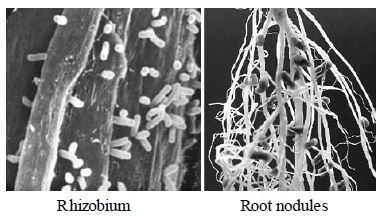
Fixation of nitrogen enriches the soil in a natural way. Fertilizers need not be added to the soil in which crops bearing root nodules with nitrogen fixing bacteria in them have been grown.
Root nodules occur on the roots of plants that associate with symbiotic nitrogen-fixing bacteria. Nitrogen fixed by the bacterium is supplied as additional nitrogenous nutrition to the host plant. In turn, the host provides shelter and carbohydrate food to the bacterium. This process, in which the bacterium and the plant live together for mutual benefit, is called symbiosis.
Rotation of Crops
Growing of a leguminous crop in between two cereal or vegetable crops is called rotation of crops. In multiple or mixed cropping, two or more crops are sown simultaneously in the same field. One of these is a leguminous crop. These crops grow and mature at the same time. For example, corn (maize) and soyabean (legume) or any other pulse are cultivated together as Kharif or summer crop.
Nitrogen Cycle

Chemical Fertilizers
Any nutrient added to the soil for improving its fertility is called a Fertilizer. Fertilizer may be natural (compost made from farm waste or the green manure) or synthetic (prepared from chemicals in Fertilizer factories).In common use, manure or compost is a natural fertilizer and chemical compounds are synthetic fertilizers or simply fertilizers.
Composition
Fertilizers are chemical compounds of mineral nutrients for plants. They are prepared in Fertilizer factories. The essential parts of nutrients are, Nitrogen (N), Phosphorous (P) and Potassium (K).
Fertilizer may be a mix of three major plant nutrients such as Sulpha mix (NPK) or single nutrient such as Superphosphate (P), Potash (K), or Urea (N).
Some common fertilizers used by farmers, in addition to the above are Di-ammonium phosphate (DAP) and Calcium ammonium nitrate (CAN)
Examples :
Some common fertilizers are : Urea, Super phosphate, Potassium sulphate, Ammonium phosphate, Potassium phosphate, etc.
Note :
i) Fertilizers are highly hygroscopic (absorb water) and leach soon into the soil.
ii) In addition, some micronutrients like sulphur and magnesium compounds are also added to the soil.
iii) Lime is often added to the soil to neutralize its acidity
Application of Chemical Fertilizers
Time of application of different fertilizers is different for different crops and at different stages of growth. Some fertilizers are added to the soil at the time of sowing, some at the time of stem elongation and leaf growth, and some towards flowering and reproductive growth.
Points to be noted during their application
i) Fertilizers should be used with utmost care.
ii) Too much use of fertilizers can upset the chemical nature of the soil and also result in the ‘burning’ (browning) of the leaves of the crop plants
iii) Fertilizers may also leach into the soil with rainwater to poison the groundwater. Otherwise fertilizer is the sure, fastest and easiest way of providing mineral nutrition to the crop plants.
Organic Farming
Worms, specially the earthworms, are a great friend of farmers. They flourish well in moist soil rich in decaying organic matter. Worms eat into the soil to burrow themselves, leaving behind the casts and canals, making the soil airy, soft and fertile The Government of India has established National Institute of Organic Farming with its Head Quarters at Ghaziabad and six regional offices, each at Bengalooru, Hissar, Jabalpur, Nagpur, Bhubaneshwar and Imphal, and a centre at Ludhiana.
5.8 WEEDING
Weeds are plants other than crop plants, growing along with crop. Weeds grow vigorously and draw more nutrition from the soil than the crop plants. This makes the soil poor in minerals and deprives the crop of its mineral needs. They also block full sunlight and air from the crops. So, they should be removed as early as possible, but certainly well before they flower and bear seeds so that they are not able to multiply.
Some Common Weeds
(i) Chenopodium (bethua)
(ii) Amaranthus (chulai)
(iii) Convolvulus
(iv) Argemone (piladatura)
(v) Datura
(vi) Alfalfa
(vii) Wild pea
(viii) Wild oat
(ix) Other grasses
The process of removal of Weeds from the crop fields is known as Weeding.
Weeding – Methods
i) Weeding by Hands :
Pulling out weeds with hands is the most common method.
ii) Weeding by Herbicides :
Herbicides are chemicals which are poisonous for weeds but do not affect crop plants.
iii) Weeding by Biological Control :
Some worms and insects have a special affinity for certain weeds on which they flourish, eating and killing them without harming the crop plants. These organisms are cultured and reared on weeds
5.9 IRRIGATION
Water is essential for the growth of plants. Different crops need varying amount of water at different phases of their growth.. Proper watering of a crop at the right time is called irrigation. At times, the rains are scarce and the crops fail due to draught or there are heavy rains and crops get damaged due to floods. To overcome the dependence on rain, various irrigation schemes for efficient use of water resources are drawn depending upon the source of water.
Irrigation Schemes
Canal irrigation, raising of dams, from rivers and streams, Groundwater irrigation from wells, tube wells, lakes and ponds. In almost all the states of India there are dams to store runaway water behind them and canalize them for irrigation. Also, the water falling from dams is used for the generation of hydroelectricity. In certain cases, the fields are flooded with water from tubewells or canals. Too much of water goes waste in this type of flood irrigation. Flood irrigation is required only for paddy crop. Fields are irrigated from time to time to save the crops from draught. Paddy (rice) is the only crop, the saplings of which are planted in flooded fields. Even paddy is watered sparingly towards the maturation of the crop. Vegetable crops are irrigated almost daily with surface irrigation, through drip irrigation or sprinklers. Sprinkler irrigation is considered most effective for herbs. It saves on water.
5.10 HARVESTING
Gathering the produce(grains, seeds or fruits) on maturity of a crop is called Harvesting Matured crop plants are cut close to the ground by different means.
Manual Harvesting
It is done with hands with the help of a hand-sickle. This has been a practice for long and small marginal farmers still make use of this method. Dry matured crop plants are cut at the ground level and are stacked in bundles for threshing,
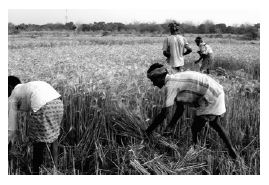
Threshing :
Threshing is the separation of grains from the chaff.
It is done in different ways :
a) At a time, small bundle of crop plants is threshed upon a stone slab
b) Bullocks are made to tread upon the ‘ears’ full of grain as in corn (maize), etc.
c) Mechanical threshers and shellers are used to bring out grains and also remove husk from the grains. Shellers are used specially for removal of husk (shell) from paddy.
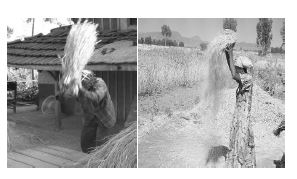
Winnowing
Grains obtained from threshing may be having husk (chaff) mixed with them. Grains are separated from husk by winnowing. The mixture of husk and grains is dropped from a height through a ‘winnow’ Husk is blown off to a distance by wind and grains being heavy fall near the platform.
Mechanised Harvesting
It is practiced with the help of machines called ‘harvester combine’. It harvests the crop, threshes and separates the husk from grains simultaneously. Clean grains come out from the machine which are stacked in gunny bags. Mechanised harvesting is convenient and fast and it helps in harvesting the crop well before the produce is affected by rain. This helps the farmer in storing or transporting the produce to the market immediately.
5.11 CROP PROTECTION
Protection from Intruders
1. Grazing Animals
Fence made from barbed wire or spiny (thorny) hedge plants is raised around the field to restrict the entry of intruders.
2. Birds and Wild Animals
Farmers put a scarecrow or bet drums to keep them away. Birds are useful for the crop before flowering and fruiting because they eat away insects, larvae and worms which feed on the leaves. Birds are harmful only when the crop starts bearing fruits and seeds, which are eaten away by the birds.
3. Rats and Moles
They are killed with the use of poison (rodenticides) in their feed
4. Locusts and grasshoppers
They are voracious eaters of leaves, buds and even stems. Locusts are small, brown or deep yellow in colour and grasshoppers are big and green.
Protection from Insects
1. Insects and germs are parasites on crops and may also cause diseases in plants. Germs may be bacteria, virus and fungi. To save crops from insects and germs, poisonous chemicals called pesticides are sprayed The pesticides may be :
2. Insecticides like Baygon, Mortein, Malathion, DDT, BHC, Methyl parathion, etc. are used for killing insects
3. Fungicides like Bordeaux mixture, Disyston, dilute solution of copper sulphate (blue vitriol), etc. are used against bacterial and fungal infections.
5.12 STORAGE OF GRAINS
Grains are dried well before storage, Stored at a dry place away from moisture, Stored in metallic bins or in silos made from mortar (cement-concrete), Stored in gunny bags in big godowns called granaries as a big reserve stock meant for Public Distribution System (PDS) for poor people or as a ‘buffer stock’ to meet emergency requirements. Nitrogen is blown into granaries to push the oxygen out.
5.13 FOOD FROM FRUITS AND VEGETABLES
Production of food is not limited to cereals and pulses. Vegetables and fruits form a good part of our food. Salad is a mixture of fruit and vegetables.
Food from fruits and vegetables can be studied under three headings :
Growing vegetables, Growing fruits, Storage of fruits and vegetables.
Growing Vegetables
The process of growing vegetables is different from cultivating cereal or pulse crops. Vegetables are mostly soft, seasonal and herbaceous plants. Their storage life (shelf life) is too short and they need immediate transportation to market for sale. Only tubers (potato), corms (ol or zamikand), rhizomes (ginger, turmeric) and bulbs (onion, garlic) can be stored that too not for long. Growth of vegetables is better in compost rich soil, which is moist, airy and porous. Use of fertilizers for vegetables must be limited. Vegetable crops are better irrigated through spray or drip method. Excessive watering may harm and destroy the vegetable crop.
Growing Fruits
The place where fruit trees are grown in called an orchard. Most fruit plants are trees or shrubs and are called plantations. Fruits borne on herbs or creepers are Cucumber, Watermelon, Melon, Strawberry and Raspberry. Each variety of fruit plant is planted and looked after in a different way. Each variety of fruit plant is planted and looked after in a different way. Seedless varieties of guava and grapes or superior varieties of apple and mango are grafted plants Graft is prepared on a rooted cut shoot (stock) from a wild but sturdy variety on which a cut shoot (scion) from a superior quality fruit bearing plant is attached.
Care of the fruit Plants
• Special care is taken of the fruit plants for better growth, flowering and fruit bearing capacity.
• Fruits planted are pruned during non-fruiting season.
• They are sprayed with pesticides for protection against pests.
• They are also sprayed with hormones for better blossoming and fruit setting.
• Honeybees are reared in orchards to help pollination for early and fast setting of fruits.
Management & Marketing of Fruits
• Fruit management is systematic and important
• It is time bound since fruits mature and perish soon after plucking.
• Fruits are packed individually and in cartons and marketed immediately thereafter.
Storage of Fruits and Vegetables
i) Fruits are plucked when fully grown but are yet to mature.
ii) Unripe fruits are wrapped individually in old newspaper pieces and then put into crates or packed in cartons.
iii) Crates and cartons are then transported to cold storages, located near fruit wholesale markets or they are put for sale.
iv) Tubers, corms, rhizomes are put for sale directly or they are stacked in gunny bags in cold storages.
5.14 FOOD FROM ANIMALS
Primarily, man has been a hunter and a flesh eater. A good amount of his food comes from animal sources. Besides hunting, man has been taming and rearing animals for rood. Some of the food products obtained from animals are :
Milk, Meat, Eggs, Honey.
Rearing of animals on a large scale at home or on a farm, taking care of their shelter, proper food, health and breeding is called animal husbandry
Milk as Food
• Cows and buffaloes are the main source of milk in India.
• In hills and plains, milk from goats and sheep is also consumed as food.
• In some places, milk from camel is also used as food, though it is not very good to taste.
• Milk yielding animals are called milch animals or milch cattle or dairy animals, as they are linked with dairy.
Flesh as Food
• The edible flesh is called meat.
• It excludes fish and poultry (birds).
• Flesh mainly comes from cattle such as cows, ox, buffalo, goat and sheep.
• Generally, males of cattle are used for their flesh.
• Some cattle are specially bred for their meat.
• Crabs and prawns are also eaten for their flesh.
Fish as Food
• Fish is highly nutritious since it is rich in easily digestible proteins and vitamin A and D.
• Fish is common in all the water bodies.
• Inland fish, found in ponds, lakes and rivers is the fresh water fish and the fish found in seas is the marine fish or saltwater fish.
• Rearing of fish on a large scale is called pisciculture.
Sea Food
• There is more life in water than on land.
• Marine fish is the largest inhabitant of sea.
• Sea food also comes from animals like prawn, crab, oyster, squids, etc.
• Some of these animals like fish, prawn and oyster are reared.
• We get tonnes of fish from sea every day.
• Government has fishery department to take care of the water bodies and to develop fish culture by introducing breeds with better yield and less bones
Poultry, Rearing of Birds for Food
Poultry is the rearing of birds like fowl (cock and hen), duck, goose and turkey for their meat and eggs. It is also called white meat and is taken as a delicacy. Eggs from birds are rich in proteins.
Honey as Food
Honey comes from honeycomb made by honey bees. Honeycomb is also called hive. Honey hive is a special kind of shelter made by bees and the wasps where a colony of bees or wasps live together. A hive made by bees is called a beehive. Since beehive stores honey, it is called honeycomb. Rearing bees for their honey is called apiculture. Apis is the scientific name for honeybee.
How are bees reared ?
For rearing bees, special wooden boxes are placed in and around orchards. Bees move in and out through the pores in the door and develop hive inside the box. These boxes are called apiaries.
What is Honey ?
Nectar collected by honeybees from flowers is sugar solution which gets concentrated on dehydration into glucose and fructose solution and gets mixed with enzymes, vitamins and minerals coming from bees Quality of honey depends upon the kind of bees and the type of flowers from where nectar is collected. Good quality honey is medicinal and may also possess antibiotic properties
Test for Purity of Honey
Pure honey when poured in a glass of water goes down forming a thread of honey in the water. Impure honey made from sugar disperses in water without forming a thread.








